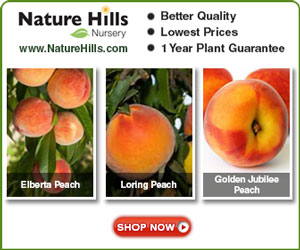Arizona Vegetable & Fruit Gardening
For The Arizona Desert Environment.
Pictures, Photos, Images
Descriptions, Information, & Reviews.
Pisum sativum.
We Are Proud Of Our SafeSurf Rating!
| Field Of Peas. Pisum sativum. All Photos Courtesy: Wikipedia, the free encyclopedia. |
|---|
| Hand Harvesting Peas. Pisum sativum. Wikipedia, the free encyclopedia. | Machine Harvesting Peas. Pisum sativum. Wikipedia, the free encyclopedia. |
|---|---|
| Snow Pea Flowers. Peas. Pisum sativum. Wikipedia, the free encyclopedia. | Pea Plant. Pisum sativum. Wikipedia, the free encyclopedia. |
| Frozen Peas. Pisum sativum. Wikipedia, the free encyclopedia. | Peas In A Pod. Pisum sativum. Wikipedia, the free encyclopedia. |
We Buy Our Hard To Find Fruit Trees For Yarnell Arizona At Nature Hills Nursery.
We Have Several Nice Fruit Trees Growing In Yarnell, Arizona.
They Will Do Well In Other Similar Elevations In Arizona. ie.. Prescott, Cottonwood, Camp Verde, Sedona.
Cameo & Fuji Apples! Yummm! Click The Nature Hills Nursery Link To View.
 /
/

Peas.
We wish to thank Wikipedia, the free encyclopedia for some of the information, and images on our page. We share information, images, and donate to Wikipedia. The pea is most commonly the small spherical seed or the seed-pod of the pod fruit Pisum sativum. Each pod contains several peas. Pea pods are botanically fruit, since they contain seeds and developed from the ovary of a (pea) flower. P. sativum is an annual plant, with a life cycle of one year. It is a cool season crop grown in many parts of the world; planting can take place from winter to early summer depending on location. The average pea weighs between 0.1 and 0.36 grams. The immature peas (and in snow peas the tender pod as well) are used as a vegetable, fresh, frozen or canned; varieties of the species typically called field peas are grown to produce dry peas like the split pea shelled from the matured pod. These are the basis of pea soup.
Stays sweet, crisp and truly delicious. Stringless. Dwarf plants grow 10-24 in. and don't need staking. 56 DAYS.
This unique new variety allows you to pick peas early for slender, crisp and stringless snow peas or wait till later to pick when the pods have filled out with 10 to 12 sweet shell peas. Prolific variety produces tons of pods if you want some of both! Plants held up to the heat better than any other variety. 61 DAYS.
Edible, 6 in. long pods are sweet and tender� perfect for salads and stir-fries. Semi-leafless 30 in. plants put more energy into producing pods, giving you higher yields. Plant 2 to 3 rows close together and plants will intertwine, becoming self-supporting. Resistant to fusarium wilt race 1 and powdery mildew. Approx. 59 DAYS.
Unmatched sweetness if picked before fully mature. Withstands mosaic virus, common wilt, powdery mildew. Bears over several weeks, setting plenty of 4 1/2-in. pods with up to 10 peas. 61 DAYS.
A premium-quality freezer pea with 6-9 peas per well-filled pod. Stands the heat better than most; resists wilt. 67 DAYS.
A favorite for over 60 years! Space-saving semi-dwarf sets huge yields of 3-in. pods with 6-9 large, sweet peas. Good for freezing. 62 DAYS.
Small vines grow 24-30 in. tall with no staking needed. Tender pods cook up sweet and crunchy. Freezes well, with no loss of color or flavor. Resistant to mosaic virus, powdery mildew and wilt. 68 DAYS.
Stringless 3-in. pods keep their rich color and crunch after cooking. Dependably wilt and frost resistant. 5-to 6-ft. vines produce heavy yields over a long season. 70 DAYS.
Produces more peas with less foliage. Leafless tendrils intertwine to produce strong, self-supporting plants that grow 26-28 in. tall. Pods are 3 to 3 1/2-in. long and the sweet peas are fantastic eaten fresh, cooked or frozen. Resistant to fusarium wilt race 1 and 2, pea enation and powdery mildew. Tolerant of fusarium root rot. 68 DAYS.
An extra-early producer, Misty sets huge yields of 3 in. pods full of plump, sugary peas. 17 to 19 in. tall plants are resistant to fusarium wilt race 1 and an excellent choice for organic production. 58 DAYS.
1. Early to mid-October is the best time to plant pea seeds for spring bloom. 2. Cultivate your planting area to break up any hard soil, dig down about 12 inches, keeping your rows about 18 to 24 inches apart. Plant seeds about 1/2 to 1 inch deep and 1 inch apart. Plant seeds at weekly intervals for continuous blooming. Pea varieties prefer well-draining, sandy, loose soils with plenty of organic matter. Try to avoid clay soils. dig down to a depth of 12 inches. Soak the seeds for 48 hrs, and plant seeds about an inch deep. Most peas are climbers and will need a vertical support or trellis. 3. Don't fertilize the soil too much. Peas are especially sensitive to too much nitrogen, but they may like a little bonemeal, for the phosphorus content. Use starter solution for transplants. Fertilize peas twice a month with small amounts of plant food. Recommended rate is: fertilize peas sparingly with 2 to 3 pounds of 5-10-10 fertilizer per 100 feet of row. 4. Purchase certified pea plants from your local garden center or nursery. 5. Peas should be thinned to about 6 inches apart for standard spacing. When the seedlings are 1 or 2 inches tall, thin as desired. Rows should be 18 to 24 inches apart. Once planted, soak thoroughly and keep the soil moist, but not wet. 6. Water your peas once or twice a week when the soil feels dry to the touch. Do Not Spray Water On Your Plants. Peas have shallow root systems so they only need a light watering to maintain constant soil moisture. Water sufficiently to moisten the soil to a depth of at least 6 inches. Mulching can help to provide uniform moisture, conserve water and reduce weeds. 7. Monitor your pea plants for disease and pest problems. Peas grown by spraying water in Arizona, often suffer from late blight, which can be treated with a fungicide. Control common pests such as snails, potato tubermoth and aphids by sprinkling nontoxic diatomaceous earth around the affected garlic plants. 8. Peas should be ready for harvest in about 45 days after transplanting. When starting from seed, expect 60 days to maturity. Harvest peas when they reach full size. Taste some prior to picking. The time frame for the entire pea harvest usually lasts one to two weeks if all peas were planted at the same time. Both tender hulls and seeds of peas are edible. Tender, edible pods come from the early harvest. Learning how to harvest pea seeds and how to harvest pea pods is a matter of timing and which part of the vegetable you prefer to use. �Sugar snap pea varieties should be tender, with immature seeds, when harvesting peas for pods. �Snow peas are ready for harvest when pods are developed, before pea seeds appear. �Garden (English) peas, grown for seeds, should be developed but still hold tender peas when harvesting.
Reduce disease problems by:
Pests Of Peas In Arizona:
Beneficial Insects Of Peas In Arizona:
Not all insects found in our gardens, & orchards are pests. Many organisms benefit the grower by eating or parasitizing pests in the orchard. These organisms are known as beneficials, natural enemies, or biological control agents. They may be native or introduced from other areas. Beneficial natural enemies (insects and mites) that may occur in our gardens, & orchards could be classified as predators or parasitoids. Predators are those that attack, kill, and feed directly on a pest (prey). Examples of common garden, or orchard predators are ladybeetles, flies, lacewings, wasps, bugs, ants, spiders, and predator mites. Parasitoids are insects that lay eggs on or in a pest (host). The developing larva lives and feeds on the host, parasitizing and eventually killing it. Examples include parasitic wasps such as the egg parasite, Trichogramma sp. Bees are a different class of beneficial insects in the garden or orchard in that they benefit the grower by aiding pollination. It is important that growers are able to recognize, identify, and conserve beneficials in their gardens, & orchards. Conservation of beneficial organisms is a basic tenet of an ecologically sound pest management strategy. Conservation or enhancement of beneficials can be achieved through judicious use of pesticides such as spraying only when and where needed, accurate timing of sprays, and selecting pesticides that are least toxic to beneficials. For Example: Many growers now place colonies of the Blue Orchard Mason bees in their orchards to pollinate their crops for maximum production.
Peas are usually self pollinating and do not require bees.
Quick Notes:
Type: The part that is eaten is usually the pea fruit, but sometimes the leaves are eaten.
Height: About 2 - 4 feet.
Spread: About 2 - 4 feet wide.
Flowers:Wild-type pea flowers have five sepals, two fused keel petals, two wing petals and a standard petal five petals in all, ten anthers (nine fused into a filament tube and one partially free and a single central carpel). The pea flower produces both male and female gametes. Sperm form in the pollen produced within the stamens; egg cells form in ovules within the ovary. A modified petal encloses the stamens and stigma, encouraging self-fertilization.
Seeds: Round.
Fruit: Pods containing several seeds, flattened when young but becoming roundish later, are dehiscent along two sides. The average pea weighs between 0.1 and 0.36 grams.
Blooming Time: Spring.
Leaves: The green leaves are pinnately compound and consists of basal, foliaceous stipules, proximal leafets and distal tendrils.
Elevation: 0 - 9,842 feet.
Hardiness: But little seedlings are damaged by temperatures below about 24�F (-4.4�C), larger plants can take it down to 20�F (-6.7�C) or so.
USDA Zone 3a: to -39.9 �C (-40 �F)
Soil pH requirements:
Light: Full Sun. Partial Shade in hot climate.
Habitat: Mulched areas. Well-drained soil with a 5.8 and 6.5 pH. According to Clemson University.
Native: Native to Southwest Asia.
Miscellaneous: In Yarnell, Arizona. Hardy Temp: 32�F. Water regularly; do not overwater.
|
Here Are Some Links To The Very Best & Most Popular Items Sold On Amazon.Com
To Learn More! Click The Links Below. No Obligation, Of Course!



